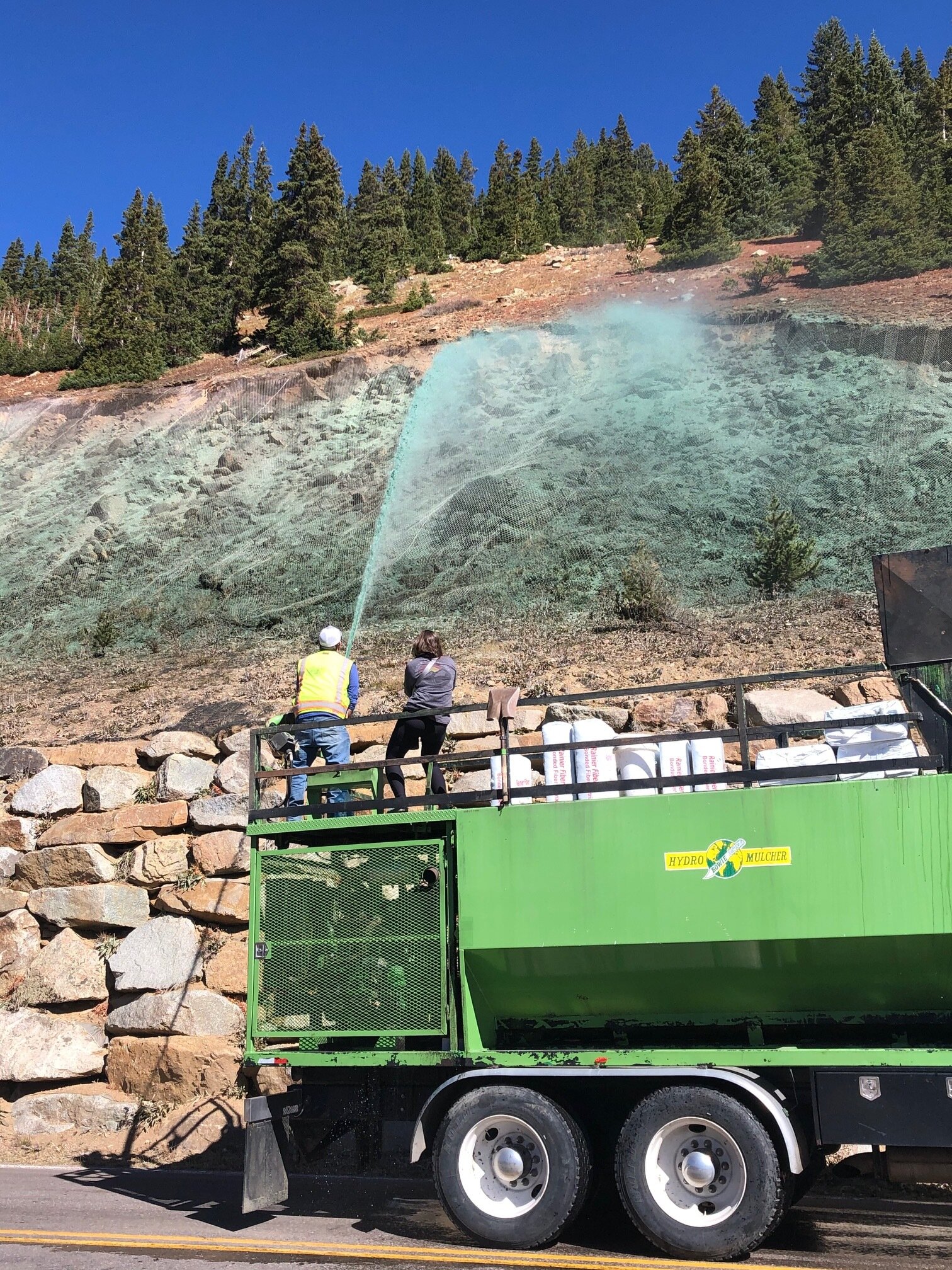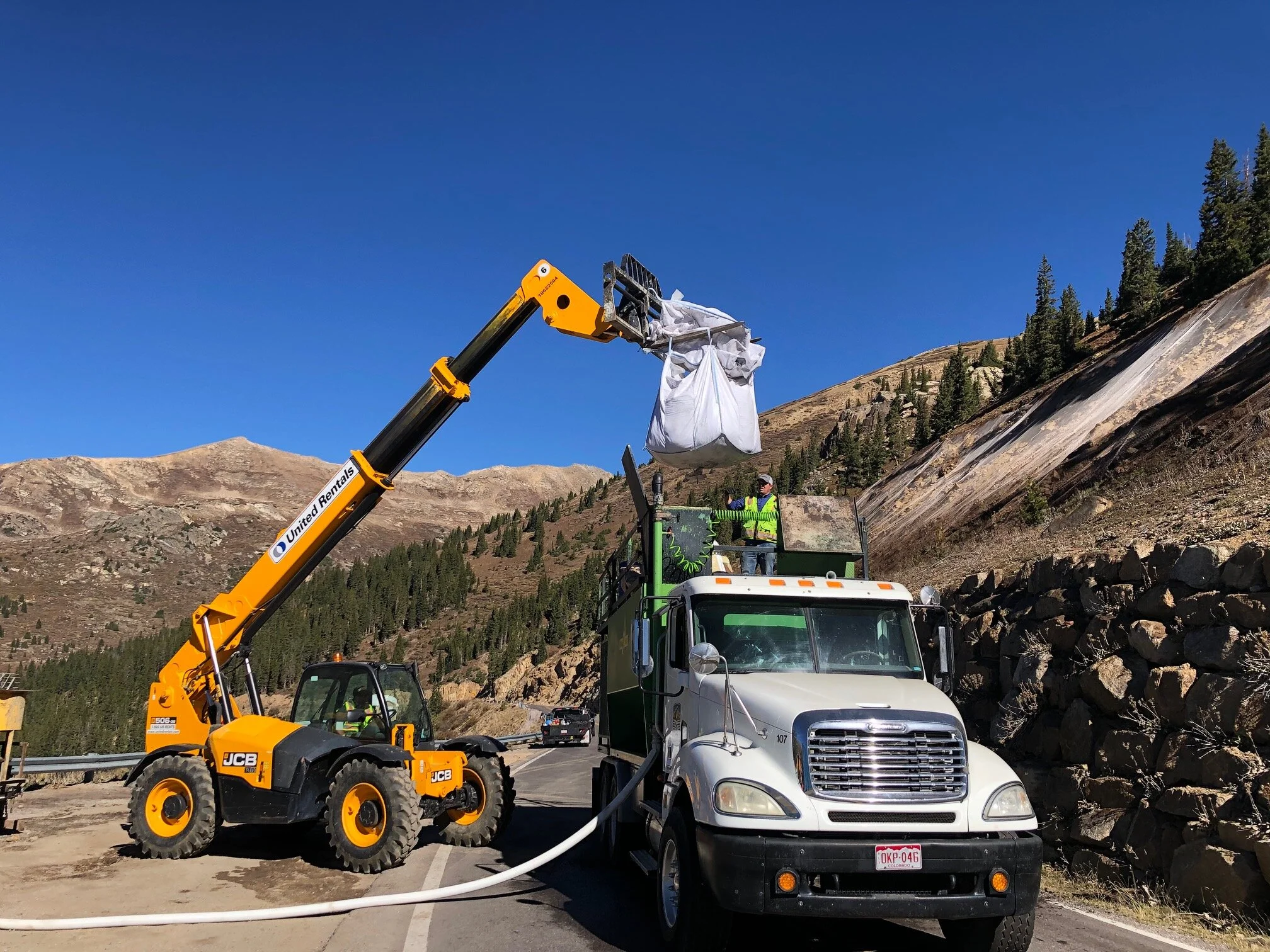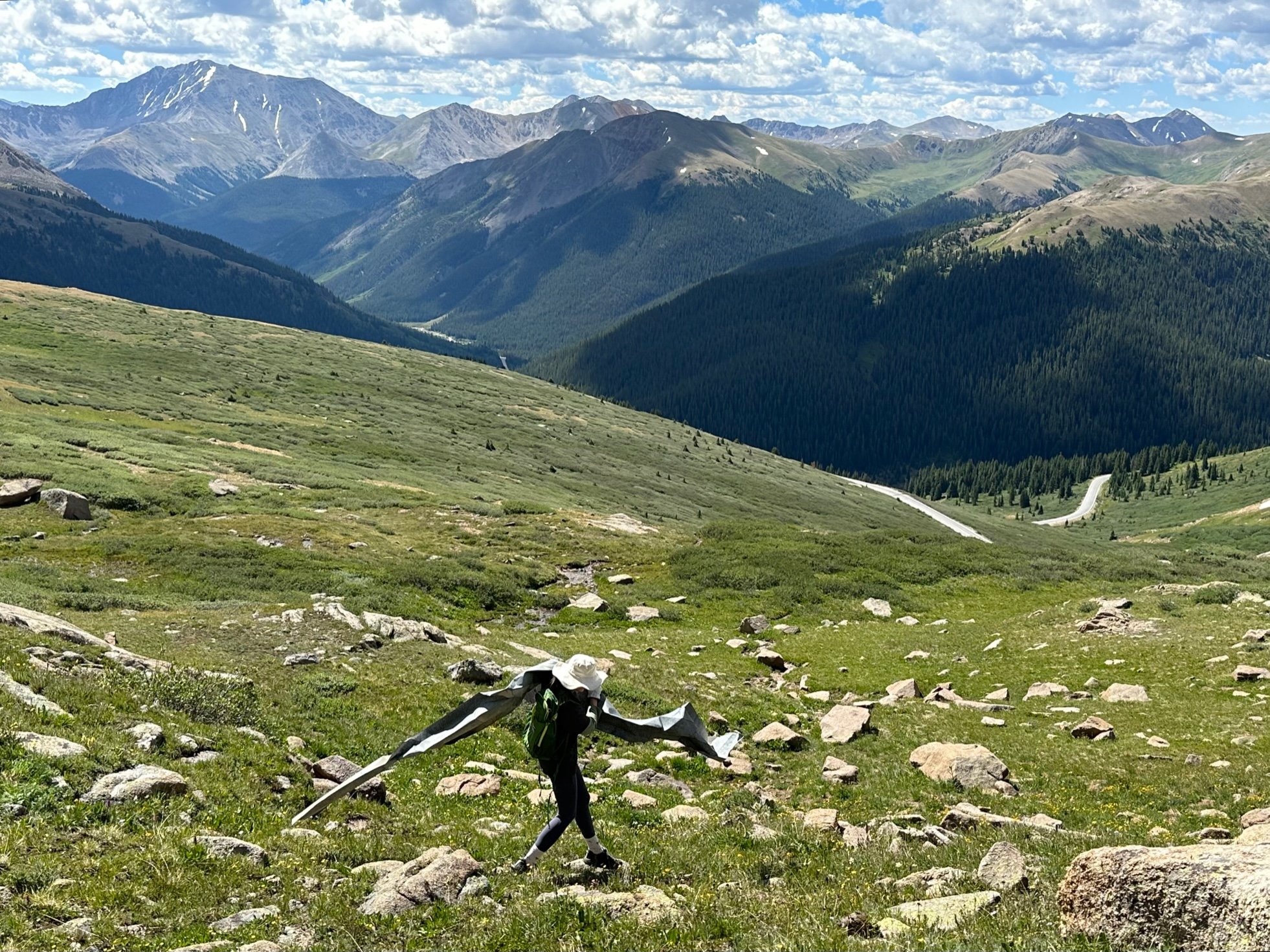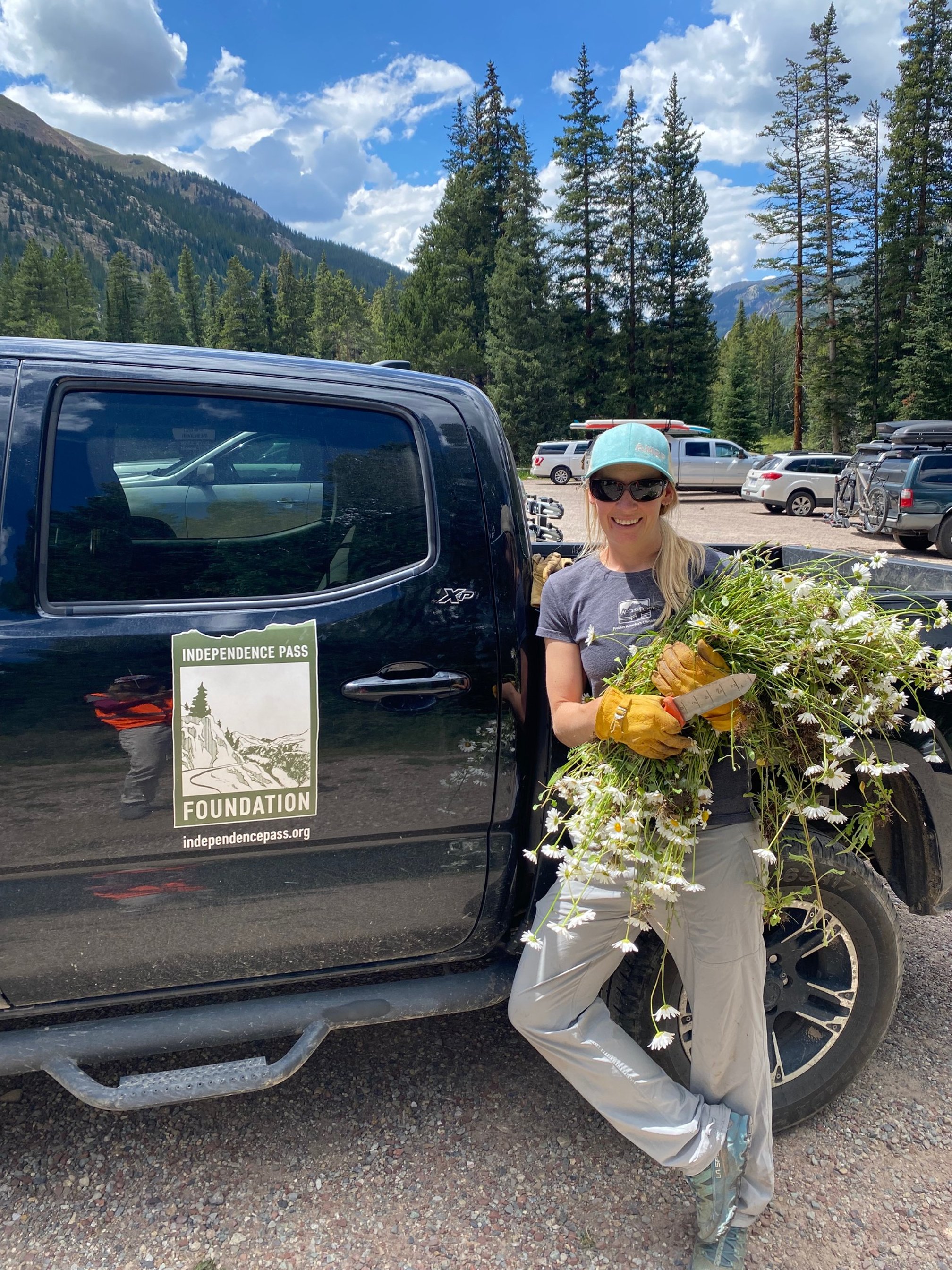Current Projects
click here to see our current and ongoing work:
Volunteer Opportunities
click here To see 2025 summer volunteer opportunities:
The Braille Trail
click below To download audio recordings for the Braille Trail, at the recently renovated Discovery/Braille Trail Day use Area:
2024 Accomplishments
to read more about the work we accomplished in 2024,
Please click on one of the table of contents buttons below,
or scroll down to see all.
New Signs Installed And Old Signs Fixed At Braille And Discovery
In the winter of 2023/24, IPF redesigned and fabricated new welcome signs at the Braille Trail, the brainchild of IPF founder Bob Lewis and the first of its kind in the world built in 1967. The elements had rendered the old sign unreadable, and, perhaps more importantly, it had never been “readable” by blind or low vision people, as it did not include Braille script (unlike the 22 signs that line the trail). With crucial input from Aftersight, a Colorado non-profit dedicated to providing audio access to print information and empowering services for blind, low vision, or individuals that need an alternative to print across Colorado, as well as sign designer Suzanne Jackson of 40BWorks, IPF remedied this flaw, creating two new welcome signs better targeted to the audience for whom they were intended.
We also fixed the Discovery Trail welcome sign—another victim of the elements—which introduces people of all abilities, including those in wheelchairs, to the natural and human history of the Pass via a series of interpretive signs along an ADA-compliant trail. And finally, installed a new, elegant bench along the Braille Trail. IPF is committed to making the Pass a welcoming place for people of all physical abilities.
Two new welcome signs, in Braille and English.
This sign was remounted in 2024.
New bench along the Braille Trail.
Naturalist Outings
In 2024, IPF led five naturalist outings, all free of charge, including two bird & wildflower walks with Mark Fuller and Rebecca Weiss, a plein air watercolor outing with Amy Beidleman, an historical tour with Nina Gabianelli of the Aspen Historical Society, and a tour of the Pass with English in Action students, staff & tutors. What a joy to dive deeply into the natural and human wonders of Independence Pass!
Karin Teague leading a wildflower walk at North Fork Lake Creek (photo Kim Levin)
Tour of Green Mountain with the Aspen Historical Society
English in Action students, tutors, and staff enjoying a day on the Pass.
Road Cut Revegetation And Stabilization
Since its inception 35 years ago, one of IPF’s primary missions has been to stabilize and revegetate slopes above and below Highway 82 that were severely impacted by roadbuilding. Through federal grants and partnerships, IPF has spent millions of dollars doing just that, especially near the summit on the west side of the Pass—what we call the “Top Cut”—and at the Weller Curve. Two lower cuts, one across from Difficult Campground and one just above the winter closure gate, are increasingly eroding and sending rocks down to the road, creating a hazard for drivers and recreationalists, and risking the Pass’s role as a critical alternative access between the Roaring Fork Valley and the Front Range. IPF has begun working with CDOT to explore stabilization options on these large, dry, steep slopes.
Board member Bob Wade hand-seeding the barren, eroding slopes above Highway 82, October 2023.
In 2020, IPF took on the mammoth project of attempting to revegetate and stabilize the slopes above Highway 82 along the Top Cut.
IPF had determined the importance of this work, along with the need for re-anchoring and in some instances replacing the metal netting preventing rocks from falling onto the road, in 2019, when it hired consultants and worked with CDOT to assess deteriorating conditions along the Top Cut. IPF applied for a federally-funded TAP grant in late 2019 to conduct the revegetation portion of the work, to coincide with CDOT’s rockfall mitigation work scheduled for the Fall of 2020.
When IPF did not obtain the grant due to a particularly competitive grant cycle, IPF’s board determined that the urgency of the work, and the synchronicity with CDOT’s scheduled Fall work, which would require among other things occasional lane closures and traffic control, great enough to merit dipping into reserves as needed to fund the effort.
Powell Restoration applying mulch over the seeds, fertilizer, and tackifier previously laid down, September 30, 2020.
After interviewing a number of suppliers and contractors, which involved numerous on-site meetings and in-depth analyses of the challenges presented by the Top Cut’s steep slopes, poor soil, high altitude, and difficult access, IPF hired Colorado companies Bowman Supplies—to provide the native seed, fertilizer, tackifier, and mulch to apply to the slopes—and Powell Restoration—to provide the thousands of gallons of water and equipment needed to spray the products 100+ feet upslope. IPF determined Bowman and Powell offered the most cutting-edge materials and approach, and best chance of success for this challenging project.
Loading materials to mix with water for spraying.
After a number of days staging water, equipment, and materials, project day itself as well as anyone could have hoped for: the weather cooperated beautifully and Powell was able to thoroughly cover the barren slopes with the seed/fertilizer/tackifier slurry followed by the mulch cover.
After application, September 30, 2020
Lower portion of Top Cut slope showing robust growth, August 23, 2021.
Tree Plantings
Three generations of Roaring Fork Valley kids have planted trees on Independence Pass, restoring road cuts, replacing trees lost in avalanches or as a result of human impacts (including former parking lots and campgrounds) , and adding to the beauty and ecological health of the Pass. IPF believes that getting kids outside, digging in the dirt, and participating in service activities that are challenging, meaningful, and fun—every time kids travel the Pass they look for “their” tree—is one of the best ways to cultivate young stewards.
Aspen Community School 6th graders planting native saplings.
IPF welcomed the new Glacier Alpine Academy to its roster of school tree planters, helping us revegetate a closed campground.
“No bit of the natural world is more valuable or more vulnerable than the tree bit. Nothing is more like ourselves, standing upright, caught between heaven and earth, frail at the extremities, yet strong at the central trunk, and nothing is closer to us at the beginning and at the end, providing the timber boards that frame both the cradle and the coffin.”
Wilderness Restoration
North summit snow fence debris
In the summer of 2023, IPF undertook the arduous process of finding and removing aluminum panels from the north side of the summit, more remnants of the unconstructed, 1960s snow fence. Over the decades, aluminum panels had been moved by snow, wind, and gravity onto the east side of the Continental Divide, as well as into hard-to-reach rock outcrops. With the help of Wilderness Workshop, Jaywalker Lodge, local volunteers, and Aspen Ski Co employees, nearly all of the metal debris was stockpiled and hauled down the mountain.
In 2024, IPF discovered a “new” area littered with rebar and aluminum cable to the north of the summit, along the lower eastern ridge. IPF will be teaming with volunteers in 2025 to pull and remove this last (?) rebar-littered area.
Aluminum pulled down and staged from the east side of the north summit.
60+ years of weathering make for awkward hauling.
60+ years of stuckness . . .
Rebar & cable at 13,165’ along ridge northeast of summit.
Rebar & cable close-up.
hazardous telephone wire removal
IPF also continued its eight-year effort to rid the Pass of abandoned, low-hanging telephone wire, which presents a sometimes deadly hazard to wildlife, as was learned in 2023 with the tragic moose death at Difficult Campground. Here, volunteers from Reese Henry & Company are carried out some of the last remaining wire below the Weller curve along the valley floor.
Cutting hazardous, low-hanging telephone wire.
A good day’s work of wire removal.
Mountain boy rebar removal
Stack of rebar awaiting mule-loading, Fall 2018
Since 2016, inmate work crews, school groups, and numerous volunteers have spent long, hard days hiking 12,500’ slopes, loosening, pulling, and prying the deeply-buried rebar out of the ground, using sledgehammers, truck jacks and chains, and tree removers. The rebar is then carried out by hand (and in 2018 by a USFS mule team).
This multi-year, physically demanding project has turned out to be a hugely popular and satisfying one for our community’s incredible kids and volunteers. IPF has identified several t-posts and sticks of rebar that remain in the basin just to the northeast of the summit of Mountain Boy, interspersed in the willows and wetlands of an area affectionately known as “Mountain Girl,” along with some remnants of an old weather station partially removed by IPF in 2016. IPF hopes to pull and haul out this last-remaining human detritus in the coming summers.
The 2018 USFS mule team hauling rebar from Mountain Boy
Nothing makes IPF Executive Director Karin Teague happier than cleaning up our backyard
Noxious weed eradication
IPF continued its efforts to keep invasive weeds at bay by hand pulling throughout the summer oxeye daisies, plumeless thistle, and yellow toadflax, a species that has taken over hundreds of acres in the Maroon Bells-Snowmass Wilderness. IPF’s director, Karin Teague, previously served on the Pitkin County Weed Advisory Board, and writes a weekly column in the summer for the Aspen Daily News/Aspen Times on wildflowers. IPF is dedicated to protecting the Pass’s extraordinary native fauna from invasive species, which can crowd out natives and disrupt ecological systems evolved over millennia.
Summer field ecologist Emily Maynard beating back the oxeyes at the Lost Man trailhead and campground
Native Arctic gentian, Gentiana algida, is one of the latest blooming wildflowers on the Pass
Noxious weeds are plants that have been transported either accidentally or purposefully as ornamentals from overseas. They have an advantage in their new environment because the insects, diseases, and animals that would normally control them are not found here. And as the toadflax seen near the summit of the Pass demonstrates, they are able to adapt to a wide variety of climatic and environmental conditions. As a result, invasive weeds can displace native plants at an alarming rate.
When the native plants that wildlife use for food, shelter, or nesting are gone, wildlife leaves the area. And because these weeds’ seeds can hitchhike on vehicles and like to establish themselves in disturbed sites such as roadsides, the Independence Pass corridor is prime territory for invasive species to take hold. By controlling their spread, IPF has committed to protecting the beautiful native wildflowers, plants, and wildlife that call Independence Pass home.
The winter gate berm in bloom with native blue flax (and even some white versions!)
Elk, along with moose, deer, bighorn sheep, and mountain goats, are year-round inhabitants of the Pass
Ptarmigan are one of just three species of birds who can live year-round in the high alpine of the Pass
Ecology Studies and Citizen Science Programs
IPF continues to work with experts in alpine flora, fauna, and forest health to better understand the changes our landscape is experiencing and will likely experience in the coming years as a result of climate change, including the possibilities of intensive beetle outbreaks, fire, drought, and extreme weather events.
forest health
ACES Forestry & Climate Director Adam McCurdy searching for signs of spruce beetle on dead Englemann spruce.
IPF is keeping a careful eye on the spruce beetle, which has devastated millions of acres of spruce forests to the south of the Pass and seems to be advancing in this direction. Engelmann spruce is the most prevalent species of evergreen on the Pass, and is what makes up the stunning old growth forests on both sides of the Pass. So far, there is no sign of an intensive spruce beetle outbreak on the Pass.
In contrast, Douglas fir, seen on the lower portion of the Pass, is seeing high mortality throughout our region, owing to a climate change-related beetle outbreak.
And while many (most?) things are out of our control, the good news is that for 35 years, IPF has planted thousands of native trees of different species throughout the Independence Pass corridor, creating diversity of both species and age that will help make the Pass more resilient in the face of a spruce beetle outbreak. And working with experts we will continue to consider other programs to foster resilience and promote restoration in the face of climate change and whatever else Mother Nature may throw our way.
Spruce beetle larva in the Lincoln Creek corridor
Time lapse of Linkins Lake, 1x/week, early-June through mid-September. The lake sits at 12,000’ in the Hunter-Fryingpan Wilderness.
phenology studies & wildflower checklist
IPF conducted its fifth year of phenology (timing of bloom) studies along the Linkins Lake Trail in 2024. This study, along with its bi-annual cover composition study near the summit of the Pass in partnership with AGCI, will provide baseline data on the species types, numbers, and timing of bloom of plants living in the alpine and sub-alpine regions of Independence Pass, which will be invaluable in assessing the effects of climate change in our region and in aiding restoration and planting efforts on the Pass. (Click on buttons below for this year’s data.) IPF also continued its real-time checklist of wildflowers in bloom on the Pass (click here: 2024 Wildflower Checklist).
One of the Pass’s loveliest alpine flowers, Pygmy bitterroot, Lewisia pygmaea, had another banner year in 2023
IPF works to protect the native plants we are studying through its noxious weed eradication efforts, its trail and signage work (encouraging people to stay on the trail and off the fragile tundra flowers), and its citizen science work (involving the public and enriching their understanding and appreciation of our native plants).
year-round conditions monitoring
In 2016, IPF partnered with the Aspen Global Change Institute to install a monitoring station at the summit of Independence Pass. The station, part of AGCI’s valley-wide Roaring Fork Observation Network, records real-time soil moisture, snow depths, temperatures, and wind speeds at the summit of Independence Pass 365 days/year. Soil moisture plays a role in everything from plant survival to the water cycle and runoff. Considered alongside additional weather data from SNOTEL, the USGS, and IPF, over time information from this station can offer clues as to how climate change may impact ecosystems on the Pass. To see some examples of what we're seeing, click the buttons below.
Snow depth at the iRON Independence Pass station varies quite a bit from year to year--and sometimes even from week to week! Snowpack at any site grows during a storm and later diminishes due to sublimation or melt, but because this site is above treeline, the snow depth at this station is also very susceptible to wind and may change in depth simply due to being moved around by gusts.
How deep winter snows on the Pass are plays a role in what streamflows will look like in the Roaring Fork Valley the following spring. Deeper snows also remain on the ground well into summer higher up, influencing how long the growing season will be for high altitude flowers, which impacts the insects, birds, and animals that depend on them for food.
Huge thanks to AGCI for the above descriptions and graphs. To learn more about Indy summit studies and AGCI’s work throughout the valley, please go to https://www.agci.org/iron/station/independence-pass
In addition, we installed a time-lapse camera known on the monitoring station to take photographs eight times a day, 365 days a year. Stitched together, the images create a movie portraying the ever-changing conditions at the summit, including the rising and falling snowpack, the emergence of alpine plants in the spring, and the tundra’s changing color from green to gold in the fall. Below is a three minute “movie” of the Pass from October 2022 through October 2023, capturing the snow build-up, snowmelt, the greening & browning of the tundra, and the occasional Homo sapien!
Pika study
Finally, IPF is a proud sponsor of the Colorado Pika Project, a partnership of Rocky Mountain Wild, the Denver Zoo, and the White River National Forest, which is employing citizen scientists to participate in a multi-year study of pikas in our region.
Megan Mueller, Senior Conservation Biologist with Rocky Mountain Wild, says, “with the help of volunteers, we will be able to do research across the mountains in the White River National Forest that will improve our understanding of how climate change may impact American pika and alpine ecosystems, and inform future Forest Service management to make alpine habitats more resilient to climate change. The project will give volunteers an opportunity to contribute to research and conservation, hike beautiful places, and learn about American pika, alpine ecosystems, and climate change.”
This summer, IPF completed 7 surveys at wide-ranging locations on the Pass, thanks to summer field ecologist Cassidy Bromka. All but one contained pika or signs of pika nearby. We plan to continue these surveys in 2025 and beyond: see the sample data and study summaries below. If you are interested in participating next summer, please contact Karin Teague, director@independencepass.org.
Trail Projects
In 2024, IPF tackled the daunting project of clearing many years of avalanche debris and new growth from the 1880 wagon road that runs through the Grottos Day Use Area to Lincoln Creek and the Lincoln Gulch Campground. Partnering with the City of Aspen’s Community Development Department and Jaywalker Lodge over several days, the way was cleared, restoring the historic way, allowing campers the opportunity to access the popular area—where the small parking lot is frequently full—via the old road.
Old road before . . .
Jaywalker Lodge clients clearing the way.
The historic wagon road restored.
IPF also tackled some of the worst potholes on the Pass’s most popular trail, the summit outlook trail, which sees thousands of visitors from all over the world every year. Members of the Holland & Hart law firm and other community volunteers did the heavy lifting of moving asphalt to the site and filling the holes, what we hope will be a temporary stop gap until the trails are realigned and replaced in the next several years.
Hole at peakfinder summit before . . .
After . . .
Holland & Hart volunteers
In addition, as it does year in and year out, this year in partnership with local climbers, Roaring Fork Outdoor Volunteers, and the US Forest Service, IPF continued its maintenance work on important climbing access trails and the much-loved Lost Man Trail.
Replacing the broken Lost Man bridge.
Step work at the popular Classy Cliffs Trail.
Rock steps built by RFOV and Aspen Rotary up a steep section of the Linkins Lake Trail.
Lincoln Creek And Watchdog Work
Lincoln Creek at the Grottos on July 16, 2024
IPF and its partners in the Lincoln Creek Work Group conducted summer and fall-long sampling and monitoring of Lincoln Creek, from Ruby down to the confluence with the Roaring Fork River and below. IPF also took the lead in identifying and eventually hiring LRE Water, experts in acid mine and acid rock drainage, to review the data collected, conduct a site visit, and advise the Work Group as to potential remediation options. We plan to get a phase 2 of expert work underway in 2025, to determine what can be done to bring heavily contaminated Lincoln Creek back to life, and to protect the Roaring Fork River from the same fate.
Site visit to Lincoln Creek near Ruby with LRE Water’s Brent Johnson.
Rare earth metal sampling on Lincoln Creek with CU grad students.
IPF also continued its year-round efforts to keep the US Forest Service, CDOT, Pitkin County, and other partners apprised of off-roading and snowmobiling in Wilderness, oversized vehicle use, illegal campfires, and other activities that threaten human safety and the ecological health of the Pass.















































